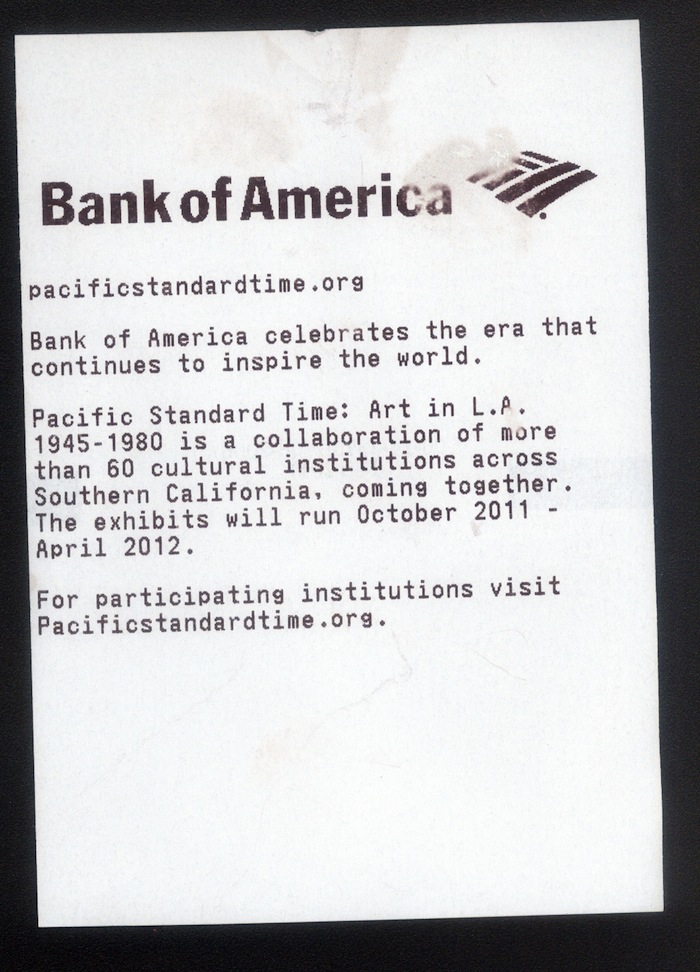
A friend sent me her Bank of America ATM receipt with its upbeat encouragement to explore the Pacific Standard Time website. Could there be a crueler indictment of an art world that is convinced of its moral superiority to mainstream culture than to be subsidized by one of the criminal financial forces that has brought our culture to its very knees?
I was seriously considering a boycott of the entire Pacific Standard Time when I saw an entity sponsoring a cultural event after basically destroying the culture via the economy. For BofA to celebrate the very pulse that it now has contributed to killing is disgusting. But the era of the boycott seems to have vanished -- instead of the boycott's zero attention, the "occupy" era challenges power by giving perpetrators 100 percent attention. While there is a call for people to remove their money from large financial institutions on November 5 and open accounts at a local credit union, how do we as a region remove the art that defines our city and our times from the large art institutions? I suppose you don't need an answer to begin your occupation of the art institution of your choice. And if you cannot choose one, don't forget that the big banks collaborate with art educational institutions to profit mightily off of student loan debt. Curricula in the hallowed halls of these capitalist MFA casinos mimic the self-impressed non-engagement aesthetic as much or more than most PST exhibits. The anxiety is erased into the conceptual ether. Prozac is to art creation what the Getty is to art curation.

Of course the blandest artists of the era dominate in the Getty's sober SoCal narrative -- maybe they're also too big to fail. Instead of a critical examination about how the imbalance of American wealth was mirrored in an imbalance of a few plain-Jane artists getting a disproportionate share of the sales and attention, we get ad agency commercials. PST contents itself with insisting some trendy actor go to the museum like your mom crabbing for you go to mass on Easter Sunday—and implying that art is like Lourdes drinking water and can make local rock stars suddenly erudite.
So who else wants to jump into bed with these perfect bedfellows? Bank of America is a "too-big-to-fail" institution that is under populist attack. The Getty is a "too-big-to-fail" institution that does more harm than good when it waters down an anarchic era into "gosh, golly, gee we're so inclusive this time!" A soul searching of the artists at the top of the Pacific Standard Time food chain is much more in order than for those laggards that history forgot and who are being thrown a bone with inclusion in a little exhibit here or a solo show at a dinky institution there.
Let's hold out hope that there is a great Pacific Standard Time art exhibit awaiting us beyond these usual two suspects. PST is supposed to deliver "the era that continues to inspire the world" (said with a straight face without any reference to Hollywood). What inspires the world? Apparently lots of text, lots of claims that other art is the only thing that influences other art. The Getty should swap places with Taschen. Every time I pick up a Taschen book, I wish I were walking through each page in some oversized museum. Every time I walk into an exhibit associated with the Getty I look out for the staples binding it together, it so resembles a walk-through term paper with occasional illustrations.
But Taschen would be a blessing. Europeans actually get Los Angeles. New Yorkers are just embarrassed to be here and try to network the most of their stay to pad their job history for the inevitable move back to Queens. This expansive survey of postwar Los Angeles contemporary art is the brainchild of tired New York academics. In sports, they call this East Coast Bias. The history of the Los Angeles art scene is getting the "gee whiz" media glance that Joe Torre got when he left managing the Yankees for the Dodgers. The clucking of the blizzard and brownstone crowd goes something like this: We just can't believe that everything does not happen in New York and that any person who matters doesn't live in New York, but if you are going to commit suicide (the term New Yorkers use for leaving New York) you may as well enjoy exile in nice weather.
Of course, stupider Angelenos are so infatuated with New York that they roll over and take whatever Big Apple expatriates are serving, not that there has been a single innovation in art in New York since Jackson Pollock (and don't remind them that he did so on Long Island). A gaping hole in PST is the reminder that Andy Warhol's soup can paintings debuted in Los Angeles in 1962. But the goal of PST's tiring parade of factotum art shows is for New York curatorial prowess to contain the greatness of Los Angeles instead of celebrating the near century of the west coast's inarguable cultural superiority to New York.
Will anyone else stand up to this cliquish coagulation of tourists showing up to tell us natives that our city matters because a few L.A. artists are so great that their names are known in New York? Like Leona Helmsley feeding filet mignon to her dog, the Getty has claimed ownership of the wildest days and nights of this town's lore and has fed them to the least deserving: academics and advocates of the international style with no allegiance to the region. No matter how radical the artist or the artworks, the only reason not to bring children to Pacific Standard Time shows is the absolute boredom they will evince. They will point out the Emperor Getty isn't wearing any clothes and what is dangling there on display is tiny and dull.
Like Bank of America, the Getty measures greatness in the current price tag of the objects from the recent past. The more money that something you touched in 1974 is worth now, the higher up you are on the Pacific Standard Time food chain. What the Getty is really banking on is your compliance with occupying the past instead of the present to enable their control of the future.
